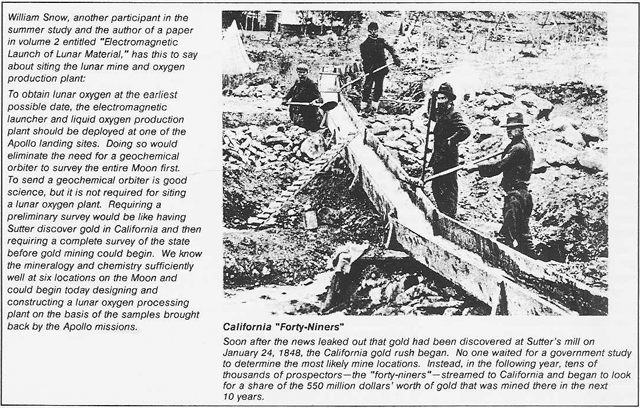
Lunar Resource Evaluation and Mine Site Selection
A. Edward Bence
I have considered two scenarios in this evaluation of lunar mineral resources and the selection of possible mining and processing sites. The first scenario assumes that no new surface or near-surface data will be available before site selection (presumably one of the Apollo sites). The second scenario assumes that additional surface geology data will have been obtained by a lunar orbiter mission;- an unmanned sample return mission (or missions), and followup manned missions.
Regardless of the scenario, once a potentially favorable mine site has been identified, a minimum amount of fundamental data is needed to assess the resources at that site and to evaluate its suitability for mining and downstream processing. Since much of the required data depends on the target mineral(s), information on the resource, its beneficiation, and the refining, smelting, and fabricating processes must be factored into the evaluation. The annual capacity and producing lifetime of the mine and its associated processing plant must be estimated before the resource reserves can be assessed. The available market for the product largely determines the capacity and lifetime of the mine.
While realistic market determination is several years away, this study starts by assuming a 40 000- metric-ton-per-year lunar mining operation with a minimum lifetime of 1 0 years. This size would be sufficient to supply 100 metric tons of liquid oxygen (LOX) per year to low Earth orbit (LEO), assuming a 1 DO-percent extraction efficiency and using an additional 300 metric tons of lunar oxygen to deliver the usable lunar oxygen to LEO and to bring tankers and hydrogen back to the Moon.
A 10-year operation requires processing of nearly 500 000 metric tons of ore. In the cases of iron- titanium mare basalts and of aluminous material from the lunar highlands, this amount of ore is insignificant compared to the potential reserves. And there should be no problem defining adequate reserves of oxygen, iron, titanium, silica, and bulk materials at any otherwise acceptable site.
How does one go about evaluating an ore body on the Moon? On Earth it is fairly straightforward. Data on ore grade, grade continuity, geometry and size of the ore body, grain size and grain size distribution, state of aggregation, accessibility, local relief, availability of power and water, and environmental issues must be collected, analyzed, and evaluated for economic impact. In the terrestrial case, the underlying constraint is profitability. In the lunar case, the only constraint is that the cost of placing the final product in LEO be less than the cost of bringing it from Earth.
Physical and chemical characterization of a potential ore body (prospect) on Earth is accomplished by a detailed sampling program that includes extensive core drilling. Terrestrial remote sensing rarely locates actual ore bodies, only prospects which are then explored in more detail on the ground. It is unlikely that such a sampling program would be carried out at a new landing site. Most of the exploration for lunar mining prospects would probably be done by remote sensing. The proposed resolution of the lunar resource mapper will not yield as much site information as is already known about the Apollo sites. For this reason an Apollo site, if it contains the appropriate materials, would be the most suitable site for a regolith mining operation. Since water has not yet been discovered on the Moon, it is not considered here. However, if water (ice) were discovered in the polar regions, its availability alone could strongly influence site selection.